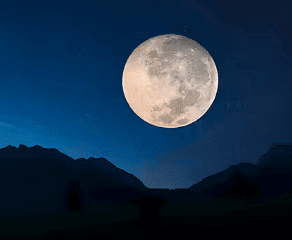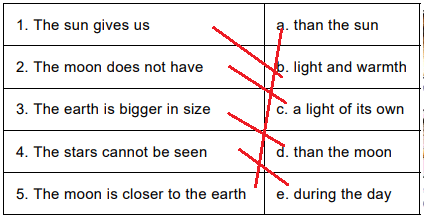Sky Above Us - 1 Class 1 Worksheet Science
Q1: To Choose the Correct Answers
(i) Which of the following is the smallest in size?
(a) Sun
(b) Moon
(c) Earth
Ans: (b)
Moon is smaller than the earth and sun. (ii) The direction in which the sun sets is the
(ii) The direction in which the sun sets is the
(a) East
(b) West
(c) South
Ans: (b)
The sun rises in the east and sets in the west.
(iii) We cannot see this in the night.
(a) Moon
(b) Stars
(c) Sun
Ans: (c)
We cannot see the sun at night. (iv) This is not hot.
(iv) This is not hot.
(a) Sun
(b) Stars
(c) Moon
Ans: (c)
Moon is not hot, Stars shine because they are extremely hot.
Q2: Fill in the blanks.
(stars, sun, moon)
(i) The ______ has no light of its own.
(ii) The _____look like tiny glowing dots in the night sky.
(iii) A day begins when the _____ appears in the sky.
Ans:
(i) The Moon has no light of its own.
(ii) The Stars look like tiny glowing dots in the night sky.
(iii) A day begins when the sun appears in the sky.
Edurev Tips:
- Moon has no light of its own.
- The stars look like tiny glowing dots in the night sky.
- A day begins when the sun appears in the sky.
Q3: Write T for true statements and F for the false ones.
(i) The shape of the moon changes every night.
(ii) Stars are closer to the earth than the moon is.
(iii) The sun moves around the earth.
Ans:
(i) The shape of the moon changes every night. True
(ii) Stars are closer to the earth than the moon is. False
(iii) The sun moves around the earth. False
Edurev Tips:
- The shape of the moon changes every night.
- Stars are not closer to the earth than the moon is.
- The moon moves around the earth.
Q4: Match the following.


Q5: Answer the following questions.
(i) In which direction does the sunrise?
Ans: The Sun "rises in the east and sets in the west".
(ii) When do we generally see the moon in the sky—after the sunrise or after the sunset?
Ans: We see the moon in the sky after the sun sets.
(iii) Name the object that is present in huge numbers in the sky and visible at night.
Ans: Stars are present in a large number in the sky and can be seen at night.
(i) The has no light of its own.
(ii) The look like tiny glowing dots in the night sky.
(iii) A day begins when the appears in the sky.
|
17 videos|89 docs|24 tests
|

|
Explore Courses for Class 1 exam
|

|

















